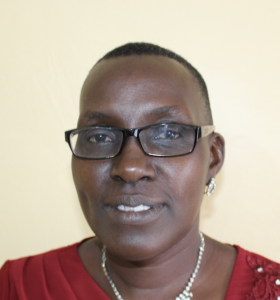Kaimosi Demonstration Primary School has two small plastic rainwater storage tanks that give students about a week of water after heavy rains. When these plastic tanks are void of water, students are required to carry water to class. It's on the students to find enough water to get through each day.
These are hard weeks for the pupils, who have sore arms and feel tired when they arrive to class with books in one arm and a heavy water container in the other. Though young, some already suffer from back pain.
The students don't enjoy recess. Any gaps in the class schedule are set aside for the students to venture back home to find water.
"I feel for our children who carry water every day from home to use in school because we have no alternative," shared Deputy Headteacher Beatrice Mideva.
Kaimosi Primary was started in 1964. They began where Kaimosi Teachers' Training College used to be, so they gave it the name "Kaimosi Demonstration." The school is growing very quickly with a current enrollment is 928 students. The headteacher told us that he admits more new students every term.
A normal school day for a student at Kaimosi Friends Demonstration Primary School begins at 7:30am as students arrive at school carrying water in their jerrycans. Class begins at 8am. Lunch break is at 12:45pm, when the students are required to take their jerrycans back home to fill with more water. This water is used to clean classrooms at 3pm after they finish their afternoon classes. Students are not actively participating in extracurriculars because they are just too worn out.
What we can do:
Training
Training will be held for two days with students, teachers, school staff, board members, and parents. The facilitator will use PHAST (participatory hygiene and sanitation transformation), ABCD (asset-based community development), CTC (child to child), lectures, group discussions, and handouts to teach health topics and ways to promote good practices within the school. The CTC method will prepare students to lead other students into healthy habits, as well as kickstart a CTC club for the school.
Handwashing Stations
The hygiene and sanitation here is poor. We noticed that there is only one handwashing facility for the teachers. The pupils have none, nor do they know of handwashing's importance.
Two handwashing stations will be delivered to the school, and the CTC club will fill them with water on a daily basis and make sure there is always a cleaning agent such as soap or ash.
VIP Latrines
The sanitation conditions of existing latrines are very poor. Most of the latrines are almost full, and the floors have cracks and holes. The doors of the latrines are broken, and some cannot even close. Some are missing doors altogether!
Because of the lack of water here, the toilets are dirty and never cleaned.
Two triple-door latrines will be constructed with local materials that the school will help gather. Three doors will serve the girls while the other three serve the boys. And with a new source of water on school grounds, students and staff should have enough to keep these new latrines clean.
Rainwater Catchment Tank
A 50,000-liter rainwater catchment tank will help alleviate the water crisis at this school.
This tank will save all of the time that's wasted as students look for enough water. We and the school strongly believe that with this assistance, standards will significantly improve. These higher standards will translate to better academic performance!

 Rainwater Catchment
Rainwater Catchment
 Rehabilitation Project
Rehabilitation Project

































